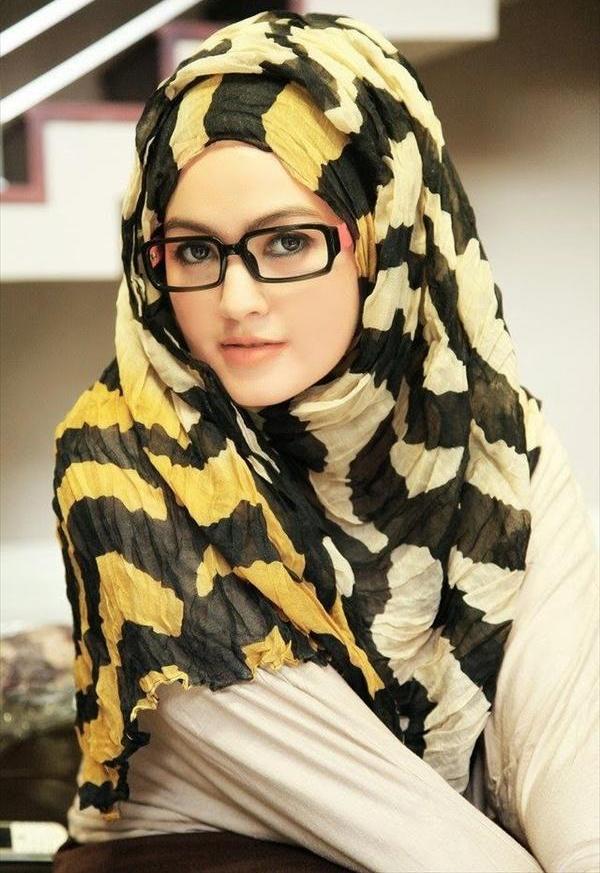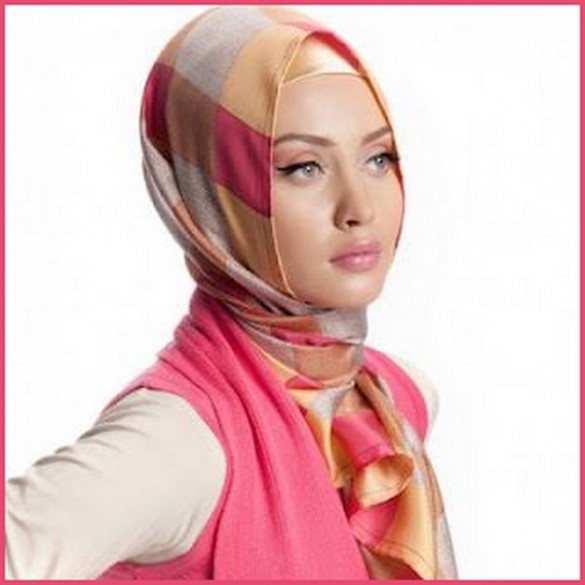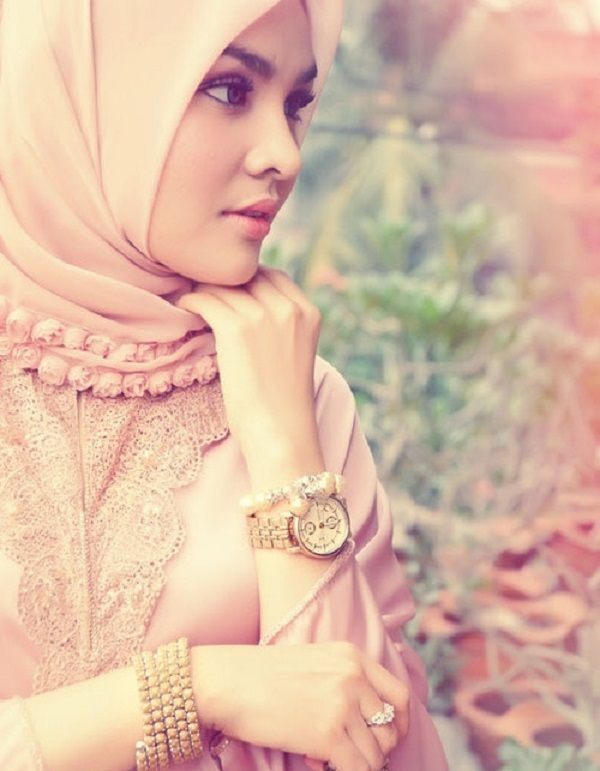About Hijab Clothing
Source (google.com.pk)
"Hijab" or "ḥijāb" (/hɪˈdʒɑːb/, /hɪˈdʒæb/, /ˈhɪ.dʒæb/ or /hɛˈdʒɑːb/;[1][2][3][4] Arabic: حجاب, pronounced [ħiˈdʒæːb] ~ [ħiˈɡæːb]) is a veil that covers the head and chest, which is particularly worn by a Muslim woman beyond the age of puberty in the presence of adult males outside of their immediate family and in front of non-Muslim females. It can further refer to any head, face, or body covering worn by Muslim women that conforms to a certain standard of modesty. Hijab can also be used to refer to the seclusion of women from men in the public sphere, or it may embody a metaphysical dimension -- Al-hijab refers to "the veil which separates man or the world from God".[5]
Most often, it is worn by Muslim women as a symbol of modesty, privacy and morality. According to the Encyclopedia of Islam and Muslim World, modesty in the Qur'an concerns both men's and women's "gaze, gait, garments, and genitalia."[6] The Quran admonishes Muslim women to dress modestly and cover their breasts and genitals,[7] but it does not specify that women cover their heads, faces or bodies.[8] Most Islamic legal systems define this type of modest dressing as covering everything except the face and hands in public.[5][9] These guidelines (for covering of the entire body except for the hands, the feet and the face), are found in texts of fiqh and hadith developed after the revelation of the Qur'an.[6]
The term hijab in Arabic literally means “a screen or curtain” and is used in the Qur'an to refer to a partition. The Qur'an tells the male believers (Muslims) to talk to the wives of the Prophet Muhammad behind a curtain. This curtain was the responsibility of the men and not the wives of Prophet Muhammad. This leads some to claim that the mandate of the Qur'an to wear hijab applies to the wives of the Prophet, not women generally.[10][11] Αlthough hijab is often seen by Westerners as a tool utilized by men to control and silence women, the practice is understood differently in different contexts.[12]
The Qur'an instructs both Muslim men and women to dress in a modest way:
"Tell the believing men to lower their gaze and be modest" (surah 24:30)
The clearest verse on the requirement of the hijab is surah 24:30–31, asking women to draw their khimār over their bosoms.[13][14]
And say to the believing women that they should lower their gaze and guard their modesty; that they should not display their beauty and ornaments except what (must ordinarily) appear thereof; that they should draw their khimār over their breasts and not display their beauty except to their husband, their fathers, their husband's fathers, their sons, their husbands' sons, their brothers or their brothers' sons, or their sisters' sons, or their women, or the slaves whom their right hands possess, or male servants free of physical needs, or small children who have no sense of the shame of sex; and that they should not strike their feet in order to draw attention to their hidden ornaments. (Quran 24:31)
In the following verse, the wives of the Prophet women are asked to draw their jilbab over them (when they go out), as a measure to distinguish themselves from others, so that they are not harassed. Surah 33:59 reads:[14]
Those who harass believing men and believing women undeservedly, bear (on themselves) a calumny and a grievous sin. O Prophet! Enjoin your wives, your daughters, and the wives of true believers that they should cast their outer garments over their persons (when abroad): That is most convenient, that they may be distinguished and not be harassed. [...] (Quran 33:58–59)
Alternative views[edit]
Types of clothes worn by religious Shia Muslims in the greater Iranian region
Some Muslims take a relativist approach to hijab. They believe that the commandment to maintain modesty must be interpreted with regard to the surrounding society. What is considered modest or daring in one society might not be considered so in another. It is important, they say, for believers to wear clothing that communicates modesty and reserve.[15]
Other verses do mention separation of men and women.
Abide still in your homes and make not a dazzling display like that of the former times of ignorance[Quran 33:32–33]
And when ye ask of them [the wives of the Prophet] anything, ask it of them from behind a curtain.[Quran 33:53]
According to at least three authors (Karen Armstrong, Reza Aslan and Leila Ahmed), the stipulations of the hijab were originally meant only for Muhammad's wives, and were intended to maintain their inviolability. This was because Muhammad conducted all religious and civic affairs in the mosque adjacent to his home:
People were constantly coming in and out of this compound at all hours of the day. When delegations from other tribes came to speak with Prophet Muhammad, they would set up their tents for days at a time inside the open courtyard, just a few feet away from the apartments in which Prophet Muhammad's wives slept. And new emigrants who arrived in Yatrib would often stay within the mosque's walls until they could find suitable homes.[10]
According to Ahmed:
By instituting seclusion Prophet Muhammad was creating a distance between his wives and this thronging community on their doorstep.[11]
They argue that the term darabat al-hijab ("taking the veil"), was used synonymously and interchangeably with "becoming Prophet Muhammad's wife", and that during Muhammad's life, no other Muslim woman wore the hijab. Aslan suggests that Muslim women started to wear the hijab to emulate Prophet Muhammad's wives, who are revered as "Mothers of the Believers" in Islam,[10] and states "there was no tradition of veiling until around 627 C.E." in the Muslim community.[10][11]
Another interpretation differing from the traditional states that a veil is not compulsory in front of blind men and men lacking physical desire.[16][17][18]
Hadith[edit]
Young Somali women in Somalia wearing the hijab.
The Arabic word jilbab is translated as "cloak" in the following passage. Contemporary Salafis insist that the jilbab (which is worn over the Kimaar and covers from the head to the toe) worn today is the same garment mentioned in the Qur'an and the hadith; other translators have chosen to use less specific terms:
Narrated Anas ibn Malik: "I know (about) the Hijab (the order of veiling of women) more than anybody else. Ubay ibn Ka'b used to ask me about it. Allah's Apostle became the bridegroom of Zaynab bint Jahsh whom he married at Medina. After the sun had risen high in the sky, the Prophet invited the people to a meal. Allah's Apostle remained sitting and some people remained sitting with him after the other guests had left. Then Allah's Apostle got up and went away, and I too, followed him till he reached the door of 'Aisha's room. Then he thought that the people must have left the place by then, so he returned and I also returned with him. Behold, the people were still sitting at their places. So he went back again for the second time, and I went along with him too. When we reached the door of 'Aisha's room, he returned and I also returned with him to see that the people had left. Thereupon the Prophet hung a curtain between me and him and the Verse regarding the order for (veiling of women) Hijab was revealed." Sahih al-Bukhari, 7:65:375, Sahih Muslim, 8:3334
Narrated Umm Salama Hind bint Abi Umayya, Ummul Mu'minin: "When the verse 'That they should cast their outer garments over their persons' was revealed, the women of Ansar came out as if they had crows hanging down over their heads by wearing outer garments." 32:4090. Abū Dawud classed this hadith as authentic.
Narrated Safiya bint Shaiba: "Aisha used to say: 'When (the Verse): "They should draw their veils (Khumur) over their necks and bosoms (juyyub)," was revealed, (the ladies) cut their waist sheets at the edges and covered their faces with the cut pieces.'" Sahih al-Bukhari, 6:60:282, 32:4091.
Hijab Clothing Abaya Designs 2014 Dress Collection Dubai Styles Fashion Pics Photos Images Wallpapers

Hijab Clothing Abaya Designs 2014 Dress Collection Dubai Styles Fashion Pics Photos Images Wallpapers

Hijab Clothing Abaya Designs 2014 Dress Collection Dubai Styles Fashion Pics Photos Images Wallpapers

Hijab Clothing Abaya Designs 2014 Dress Collection Dubai Styles Fashion Pics Photos Images Wallpapers

Hijab Clothing Abaya Designs 2014 Dress Collection Dubai Styles Fashion Pics Photos Images Wallpapers

Hijab Clothing Abaya Designs 2014 Dress Collection Dubai Styles Fashion Pics Photos Images Wallpapers

Hijab Clothing Abaya Designs 2014 Dress Collection Dubai Styles Fashion Pics Photos Images Wallpapers

Hijab Clothing Abaya Designs 2014 Dress Collection Dubai Styles Fashion Pics Photos Images Wallpapers

Hijab Clothing Abaya Designs 2014 Dress Collection Dubai Styles Fashion Pics Photos Images Wallpapers

Hijab Clothing Abaya Designs 2014 Dress Collection Dubai Styles Fashion Pics Photos Images Wallpapers

Hijab Clothing Abaya Designs 2014 Dress Collection Dubai Styles Fashion Pics Photos Images Wallpapers

Hijab Clothing Abaya Designs 2014 Dress Collection Dubai Styles Fashion Pics Photos Images Wallpapers

Hijab Clothing Abaya Designs 2014 Dress Collection Dubai Styles Fashion Pics Photos Images Wallpapers

Hijab Clothing Abaya Designs 2014 Dress Collection Dubai Styles Fashion Pics Photos Images Wallpapers

Hijab Clothing Abaya Designs 2014 Dress Collection Dubai Styles Fashion Pics Photos Images Wallpapers

Hijab Clothing Abaya Designs 2014 Dress Collection Dubai Styles Fashion Pics Photos Images Wallpapers

Hijab Clothing Abaya Designs 2014 Dress Collection Dubai Styles Fashion Pics Photos Images Wallpapers

Hijab Clothing Abaya Designs 2014 Dress Collection Dubai Styles Fashion Pics Photos Images Wallpapers

Hijab Clothing Abaya Designs 2014 Dress Collection Dubai Styles Fashion Pics Photos Images Wallpapers

Hijab Clothing Abaya Designs 2014 Dress Collection Dubai Styles Fashion Pics Photos Images Wallpapers
Hijab Clothing Abaya Designs 2014 Dress Collection Dubai Styles Fashion Pics Photos Images Wallpapers

Hijab Clothing Abaya Designs 2014 Dress Collection Dubai Styles Fashion Pics Photos Images Wallpapers

No comments:
Post a Comment